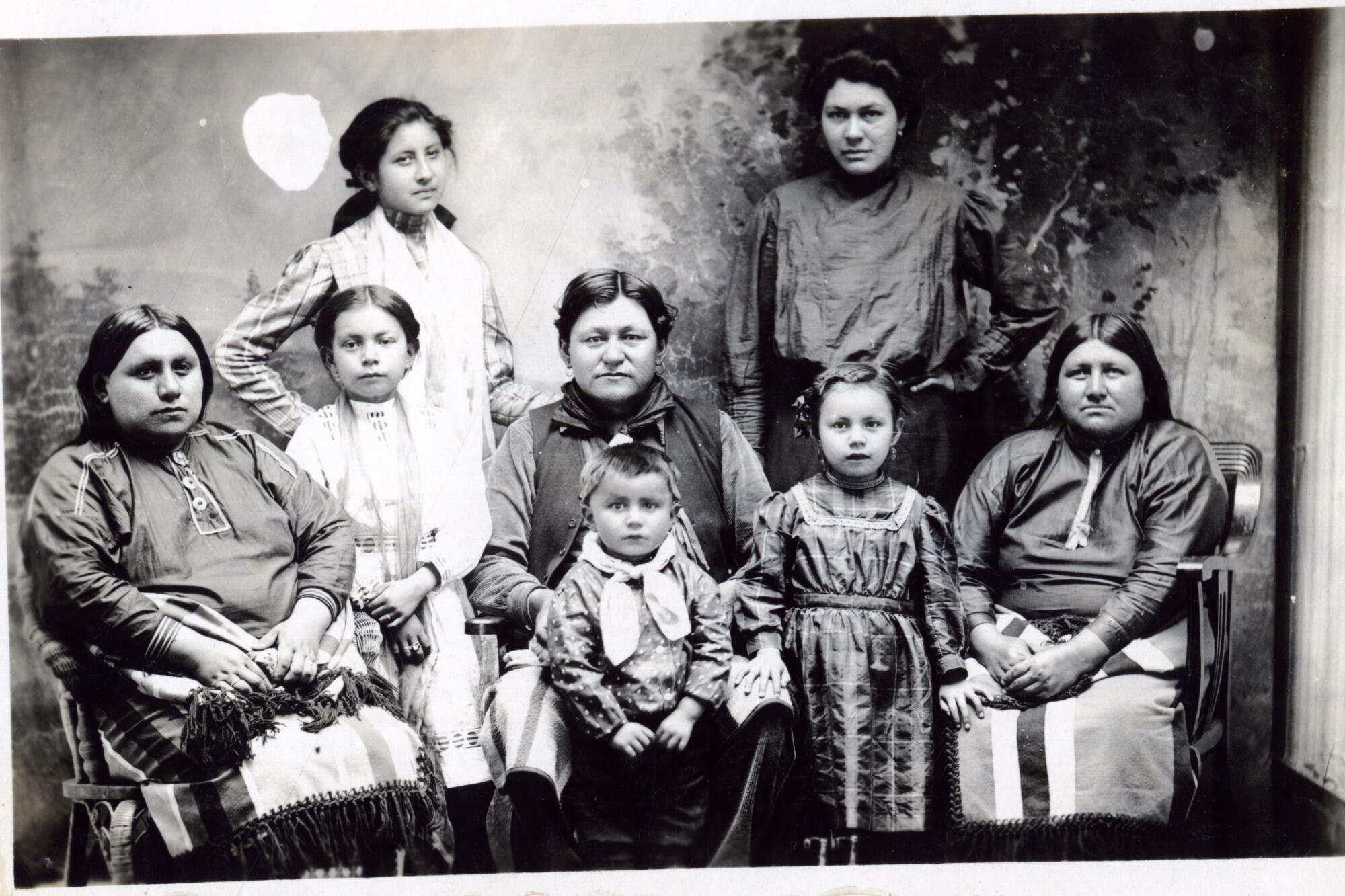
- Share via
Director Martin Scorsese’s new film, “Killers of the Flower Moon,” tells the true story of a string of murders on the Osage Nation’s land in Oklahoma in the 1920s. Based on David Grann’s meticulously researched 2017 book, the movie delves into racial and family dynamics that rocked Oklahoma to the core when oil was discovered on Osage lands.
White settlers targeted members of the Osage Nation to steal their land and the riches beneath it. At least 60 Osage people were murdered or disappeared between 1921 and 1925. From a historical perspective, this crime, made possible by federal policies from the 1880s, was just the tip of the iceberg.
From the early 1800s through the 1930s, official U.S. policy displaced thousands of Native Americans from their ancestral homes through the policy known as Indian removal. And throughout the 20th century, the federal government collected billions of dollars from sales or leases of natural resources such as timber, oil and gas on Indian lands, money it was supposed to disburse to the land’s owners. But it failed to account for these trust funds for decades, let alone pay Indians what they were due.
Martin Scorsese said he rewrote the entire script of his latest film, “Killers of the Flower Moon,” before shooting it. Read the reason behind the revamp.
I have roots in the Comanche, Kiowa, Cherokee and Taos Pueblo tribes, and from my perspective, this story of murder on Osage lands is just one small chapter in the much larger story of an entire nation built on land theft and stolen wealth.
In the standard telling, the American West was populated by industrious settlers who eked out livings on desolate land, formed communities and cities and, in time, created states. Most Americans still know little or nothing about the hundreds of Native nations who already lived on those lands, each with their own unique forms of government, culture and language.
In the early 1800s, Eastern cities were growing and dense urban centers were becoming unwieldy, and Indian lands in the West were seen as a solution. Starting in the 1830s, Congress pressured Indian tribes in the East to sign treaties that required the tribes to move to reservations in the West. This took place over the objections of figures such as Tennessee frontiersman and congressman Davy Crockett, humanitarian organizations and, of course, the tribes themselves.
Forced removal touched every tribe east of the Mississippi River and several tribes to the west of it. In total, about 100,000 American Indians were removed from their Eastern homelands to Western reservations.
But the most pernicious land grab was yet to come.
The searing, sprawling ‘Killers,’ which premiered Saturday at Cannes, is both like and unlike anything its director has ever done.
Even after Indians were corralled on reservations, settlers pushed for more access to Western lands. In 1871, Congress formally ended the policy of treaty-making with Indians. Then, in 1887, it passed the General Allotment Act, also known as the Dawes Act. With this law, U.S. policy toward Indians shifted from separation to assimilation — forcibly integrating Indians into the national population.
This required transitioning tribal structures of communal land ownership under a reservation system to a private property model that broke up reservations altogether. The General Allotment Act was designed to divvy up reservation lands into allotments for individual Indians and open any unallotted lands, which were deemed surplus, to non-Indian settlement. Lands could be allotted only to male heads of households.
Under the original statute, the U.S. government held Indian allotments, which measured roughly 160 acres per person, in trust for 25 years before each Indian allottee could receive clear title. During this period, Indian allottees were expected to embrace agriculture, convert to Christianity and assume U.S. citizenship.
In 1906, Congress amended the law to allow the secretary of the Interior to issue land titles whenever an Indian allottee was deemed capable of managing his affairs. Once this happened, the allotment was subject to taxation and could immediately be sold.
But Indian allottees often had little concept of farming and even less ability to manage their individual lands. Even after being confined to Western reservations, many tribes had maintained their traditional governance structures and tried to preserve their cultural and religious practices, including communal ownership of property.
‘Killers of the Flower Moon’ star Lily Gladstone says the Martin Scorsese film was significantly re-written to avoid telling a ‘white-savior story.’
When the U.S. government imposed a foreign system of ownership on them, many Indian landowners simply sold their lands to non-Indian buyers, or found themselves subject to taxes that they were unable to pay.
In total, allotment removed 90 million acres of land from Indian control before the policy ended in the mid-1930s. This led to the destruction of Indian culture; loss of language as the federal government implemented its boarding school policy; and imposition of a myriad of regulations that affected inheritance, ownership and title disputes when an allottee passed away. All of these destructive policies were forced on the Osage people.
Today, about 56 million acres remain under Indian control. The federal government owns title to the lands, but holds them in trust for Indian tribes and individuals.
These lands contain many valuable resources, including oil, gas, timber and minerals. But rather than acting as a steward of Indian interests in these resources, the U.S. government has repeatedly failed in its trust obligations.
As required under the General Allotment Act, money earned from oil and gas exploration, mining and other activities on allotted Indian lands was placed in individual accounts for the benefit of Indian allottees.
But for over a century, rather than making payments to Indian landowners, the government routinely mismanaged those funds, failed to provide a court-ordered accounting of them and systematically destroyed disbursement records.
In 1996, Elouise Cobell, a member of the Blackfeet Nation in Montana, filed a class-action lawsuit seeking to force the government to provide a historical accounting of these funds and fix its failed system for managing them. After 16 years of litigation, the suit was settled in 2009 for roughly $3.4 billion (direct payments to each member of the class amounted to $1,000).
“We all know that the settlement is inadequate, but we must also find a way to heal the wounds and bring some measure of restitution,” said Jefferson Keel, president of the National Congress of American Indians.
In 2011, the federal government settled for $380 million a longstanding lawsuit brought by the Osage Nation to compensate the tribe for losses to its trust funds and interest as a result of the government’s mismanagement of trust assets. In truth, that amount doesn’t come close to full reparations for the crimes committed against the Osage people by the government over two centuries.
Torivio Fodder is the manager of the Indigenous Governance Program and a law professor at the University of Arizona. This article was produced in partnership with the Conversation.
More to Read
A cure for the common opinion
Get thought-provoking perspectives with our weekly newsletter.
You may occasionally receive promotional content from the Los Angeles Times.













